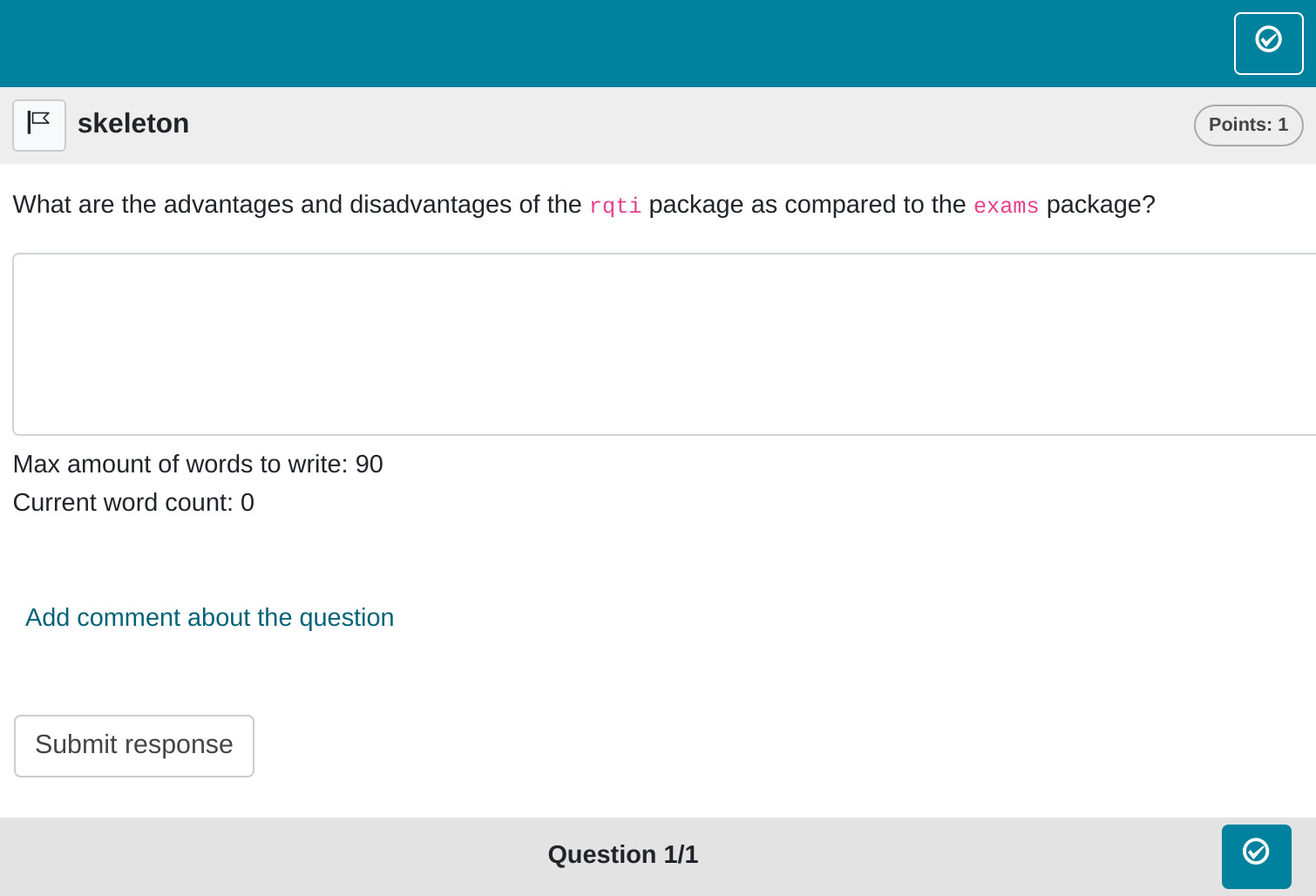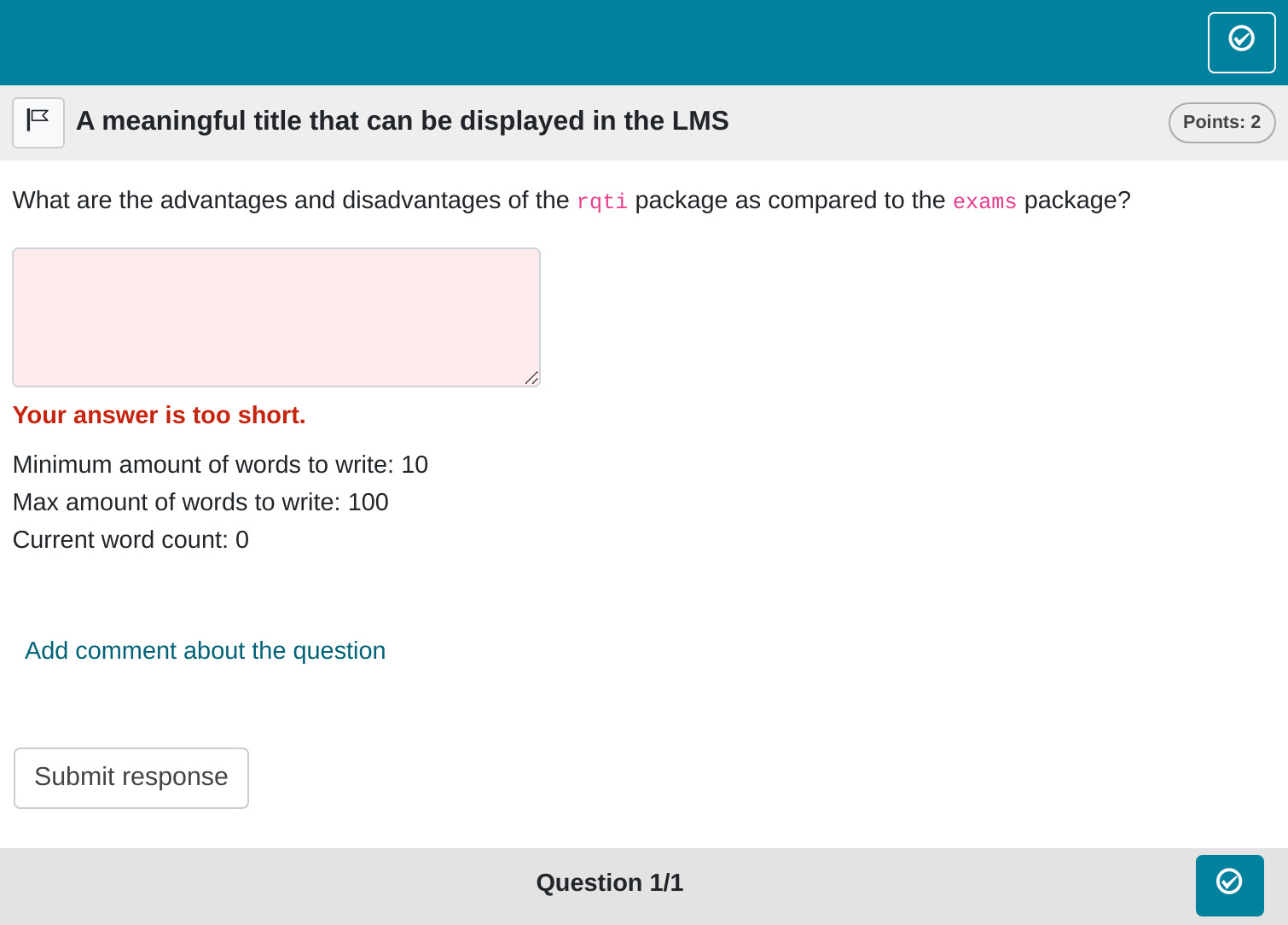This is a standard essay task with an open field for students to write a comprehensive response.
Minimum version
A minimum template is automatically created when you initiate an rqti
project through RStudio. Alternatively, it can be added by clicking on
New file -> R Markdown -> From Template. The
rqti templates end with rqti Here we look at
the templates essay (simple) and
essay (complex).
The minimum you need to provide is the type: essay in
the yaml-section and some text as a task description in a section called
#question:
---
type: essay # type of exercise
knit: rqti::render_qtijs # if you do not want our preview renderer, remove this
---
# question
What are the advantages and disadvantages of the `rqti` package as compared to
the `exams` package?
# feedback
The rqti package can only export to the QTI format, which makes it less general
than the `exams` package. But the rqti package supports more exercise types, can
preview xml files, supports the OPAL API and has an extensible core architecture
based on S4 OOP.Knitting via the Knit-Button to qtijs, this task renders as:

Alternatively, change the knit parameter to
knit: rqti::render_opal (see Working with the OPAL API) to upload to OPAL
directly, producing:

Note that in this example, a feedback section was also provided. Since an open question requires manual review, only general feedback without conditions should be provided. The feedback is optional, but usually it is a good idea to give some explanation for students. Furthermore, a feedback section for essay tasks can serve as a good basis for grading student’s answers. In addition the length of the feedback section is taken into account in constructing the text field and the maximum number of words. If no feedback is provided, sensible defaults are used.
More control
If you want to have more fine-grained control, consider the RMD
template essay (complex), which uses more yaml
attributes.
---
type: essay # type of exercise
knit: rqti::render_qtijs # if you do not want our preview renderer, remove this
identifier: essay001 # think twice about this id for later data analysis!
title: A meaningful title that can be displayed in the LMS
expected_length: 30 # defines the width of the text input field
expected_lines: 3 # defines the number of lines of the text input field
words_max: 100 # how many words can be written in the text input field
words_min: 10 # the minimum number of words to send a response
data_allow_paste: false # allows to copy text from the clipboard
points: 2
---
# question
What are the advantages and disadvantages of the `rqti` package as compared to
the `exams` package?
# feedback
The rqti package can only export to the QTI format, which makes it less general
than the `exams` package. But the rqti package supports more exercise types, can
preview xml files, supports the OPAL API and has an extensible core architecture
based on S4 OOP.Which, in OPAL, renders as :

yaml attributes
identifier
This is the ID of the task, useful for later data analysis of results. The default is the file name. If you are doing extensive data analysis later on it makes sense to specify a meaningful identifier. In all other cases, the file name should be fine.
title
Title of the task. Can be displayed to students depending on the learning management system settings. Default is the file name.
words_max
Defines the maximum number of words that can be written by the candidate in the text input field.
Feedback
Feedback can be provided with the section
- # feedback (general feedback, displayed every time, without conditions)
The feedback plays an important role in essay tasks because the expected length and maximum words are calculated from the feedback section, if one is given. Providing useful feedback also defines explicit criteria for grading, so do not skip it for essay tasks, unless you have good reasons to.
Further note that it does not make sense to give conditional feedback as essay tasks have to be graded manually.
Some advice on essay tasks
Essay tasks can be highly diagnostic, especially when instructors pose thought-provoking questions. Unfortunately, many instructors struggle with creativity and precision when crafting essay prompts, leading to vague grading criteria. To address this issue, it is recommended to always include an exemplary solution in the feedback section. This not only enhances the learning experience for students but also earns appreciation from colleagues involved in grading.